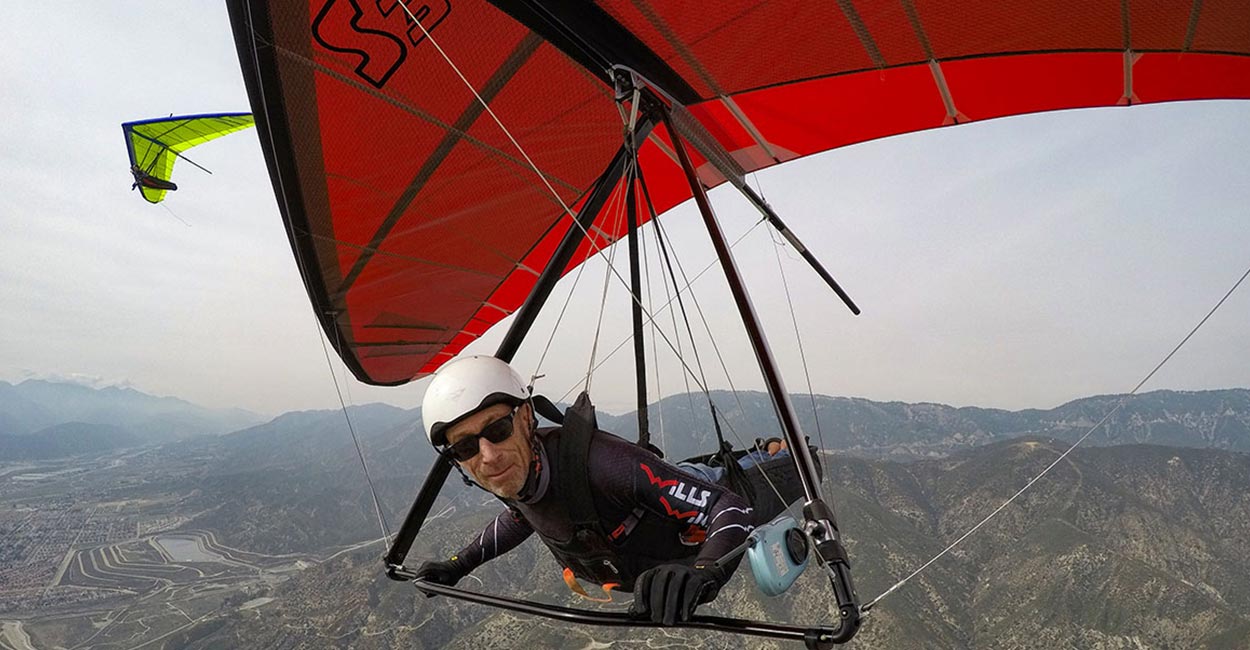Jeff O Brien takes his Wills Wings for a blast
Cross Country magazine’s Hugh Miller talks to Rob Kells of Wills Wing hang gliding. Published in 1999
I don’t get it. Your surname is Kells, but you head a company called Wills. Eh?
The Wills brothers, Bob and Chris, founded Wills Wing in 1973. It was the first-ever year of the US Nationals, and Chris won and Bob was second. In 1974 the positions were reversed, with Bob first and Chris second. Bob was killed in a hang gliding accident in 1977, after which Chris gave up flying hang gliders.
Chris is still an owner in Wills Wing, and is a leading orthopaedic surgeon in Southern California; in this business it is sometimes handy to have one of those on the team. As far as heading the company is concerned, the management has been shared equally by a team of four people; myself and my partners Steve Pearson, and Mike and Linda Meier.
What’s your perspective on the state of the sport?
Wow, that’s a pretty broad question. In Europe, hang gliding has suffered a significant decline. I believe the two main reasons for this have been the growth of paragliding, and certain marketing decisions made by the manufacturers. It takes less time to get a student soloed in a paraglider and to sell them equipment, so it is no wonder that many schools went in that direction.
The USA followed Europe to some degree in that trend, and many schools switched from teaching hang gliding to paragliding. But in the USA. many areas are not as well suited to paragliding as is Europe, and the effect on hang gliding here seems to have been less.
There has been a decline in the number of hang gliding schools in the USA, but at the same time the schools that are succeeding are doing extremely well – they are prospering financially and they are creating new pilots.
There are more than 20 successful full time schools in the U.S and Canada that are teaching hang gliding and making a good living doing it. Aerotowing has been a key part of that success. It is obvious that successful schools are the future of both hang gliding and paragliding.
You mentioned ‘certain marketing decisions’ as being a contributing factor to the gradual decease of the European hang gliding arena. Can you elaborate?
In the USA, Wills Wing has long had a policy of supporting schools and dealers, and it has helped support the health and growth of the sport.
In Europe, it seems that some manufacturers have started selling direct to pilots. In the short run this may mean a few more sales, but in the long run it drives the schools out of business and risks killing the sport. The pilots get a lower price, but if the manufacturers continue to drive the schools out of business eventually there will be no-one to buy their used glider when they want to trade up to a new one.
In a declining market it is very tempting to try and shift more gliders by missing out the schools and selling direct with lower prices, but this is a very short sighted way to do business. By hurting the schools’ ability to make a living teaching new pilots, you ruin your prospect of a bigger market in the future.
In the USA every hang gliding manufacturer that has sold direct to the pilots has gone out of business. Eventually this is likely to happen in Europe as well, because factory direct sales can only result in a declining market, and a declining market cannot support manufacturers.
So what can Europe learn from the US to try and reverse the decline?
There are a number of new things that can help hang gliding grow. Pat Denevan of Mission Soaring in California has developed a really neat flight simulator. It makes it much easier for schools to sign up new students at shows.
David Glover, from Lookout Mountain, the largest HG school in the States, started a 1-800 HANG GLIDE number. When you call this number anywhere in the USA it automatically routes your call to the nearest participating school. The USA skydiving association has grown from 15,000 members to 35,000 in the last five years. I think this indicates that hang gliding and paragliding can also grow.
Talking of redemption strategies: skyfloating, the concept of returning to our roots and flying simple, low performance hang gliders, was a Wills Wing idea wasn’t it?
Skyfloating is flying a hang glider suprone, (in a seated position above the basetube) in a paragliding harness. We sure did not invent suprone flying. I first saw pilots doing it in 1979. When we developed our Falcon we tried to make it as easy to fly as possible, because we saw that paragliding was growing and hang gliding was not.
The growth in paragliding seemed to come from ease of learning and transport, not from performance or price. The sport spawned some very comfortable harnesses, so we developed a ‘Skyfloating’ spreader bar that allows you to use your paragliding harness to fly a hang glider. There are many days that it is too windy for paragliders but fine to fly hang gliders.
Everyone involved in aviation design is merely filling in the shades of grey between parachutes and space shuttles. I think more and more pilots will try Skyfloating as an alternative to paragliding.
Nevertheless, the one huge advantage hang gliders have over paragliders is their vastly better performance. Sacrificing that won’t help tempt paraglider pilots onto a conversion course.
I’m not sure about that. Even a low performance hang glider like the Falcon has certain performance advantages over a paraglider. It can handle more wind, and it is safer in bad-ass turbulence. The way I see it, paragliders are to hang gliders what hang gliders are to sailplanes.
Paragliders are really fun in the right conditions, but in strong conditions I’d rather be hang gliding. Booming thermals, howling winds and big wave-lift, and I’d choose a sailplane. It’s horses for courses. If performance was the only reason people went gliding, we would all be flying 60 to 1 sailplanes.
I’ve just watched Ulrich Grill’s film production of the Red Bull speed run, and it was so gripping that I left my sofa’s arms in tatters. Perhaps speed gliding, with its TV coverage and adrenaline appeal, could prove to be the saviour of our sport.
It’s definitely my favourite competition format. Speed gliding and aerobatics are much more interesting to the media than cross country flying, for obvious reasons. But to what degree either of these formats can promote the sport remains to be seen.
Formula 1 car racing is the most popular sport in the world. Is it because so many of us drive cars, or is it to watch the gruesome crashes? If speed gliding continues to grow, we will definitely find out because we are sure going to have some spectacular crashes!
And on that bombshell, thanks for talking to Cross Country!
• Got news? Send it to us at news@xccontent.local
Subscribe to the world’s favourite hang gliding and paragliding magazine









